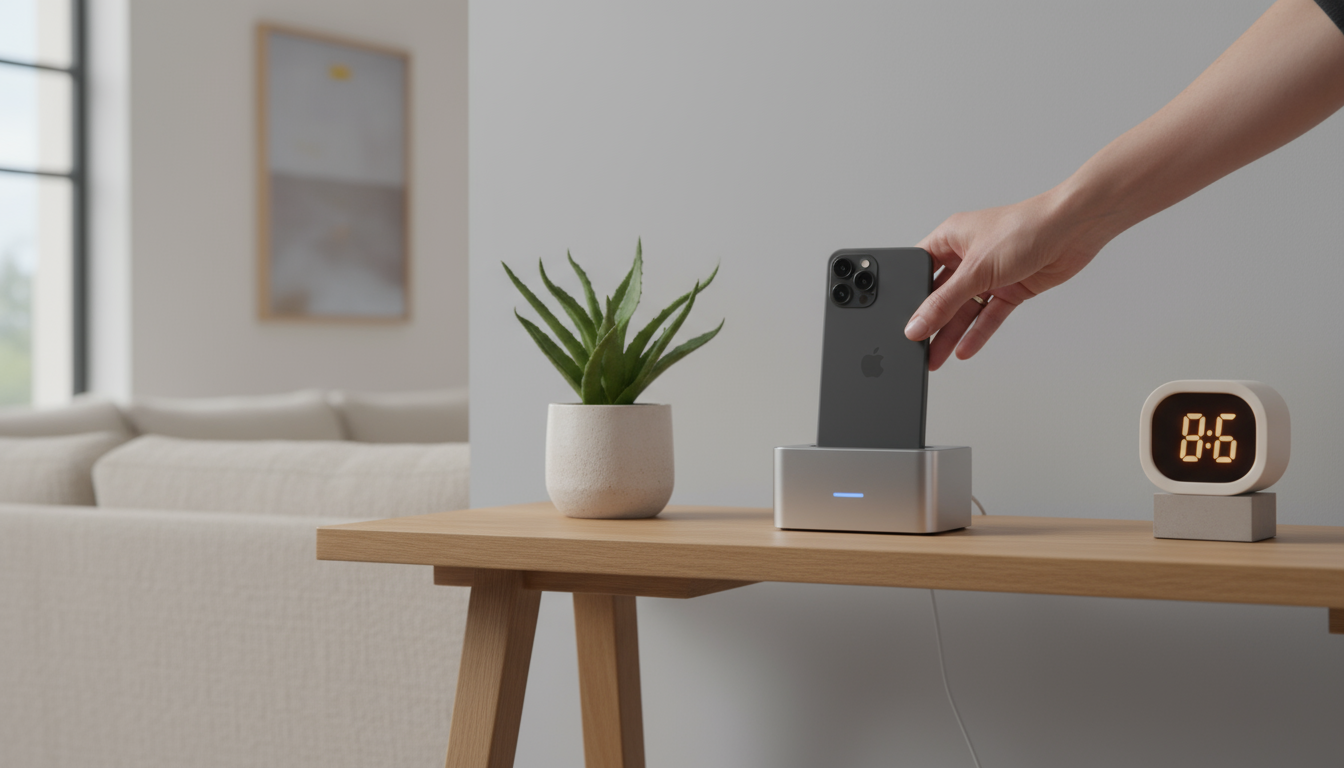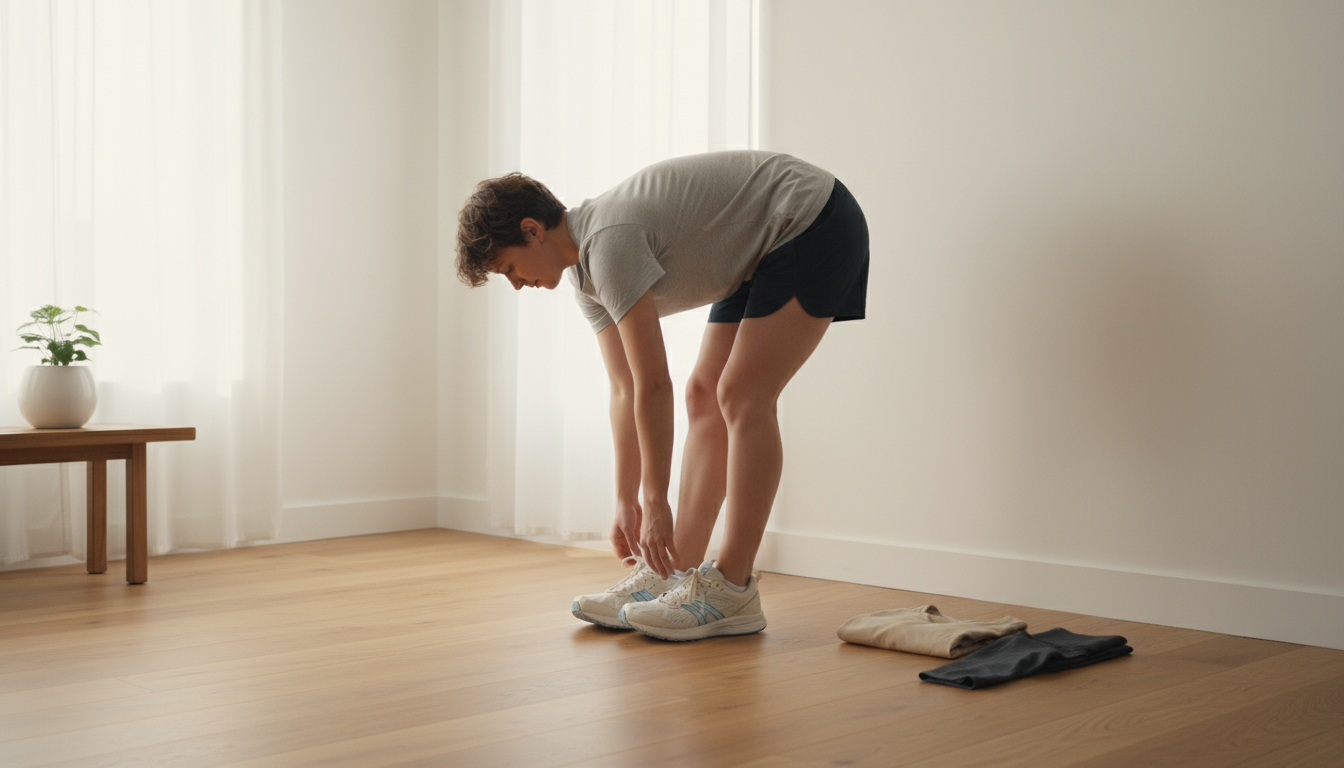
You wake up with the best of intentions. Today, you promise yourself, will be different. You’ll meditate, journal, exercise, and eat a healthy breakfast, all before your first work meeting. But then the alarm blares. You hit snooze, just once. Then again. Before you know it, you’re rushing, grabbing your phone, and scrolling through a cascade of notifications while a cold piece of toast hangs from your mouth. The productive morning you envisioned evaporates, replaced by a familiar wave of reactive stress.
If this sounds familiar, you are not alone. And more importantly, it is not a personal failing. For many of us, especially those living in busy urban environments, willpower is a resource that’s depleted before we even leave the house. We are bombarded with cues, decisions, and distractions from the moment we open our eyes. Relying on sheer determination to build a better morning routine is like trying to build a sandcastle during high tide. It’s exhausting, and eventually, the environment wins.
But there is a better way. The secret to a durable, life-changing waking up routine isn’t found in iron-clad willpower or a perfectly curated Instagram feed. It’s found in understanding the gentle, underlying mechanics of human behavior. It’s about building a system of tiny, consistent steps that work with your brain, not against it. This guide will walk you through that system. We won’t ask you to become a different person overnight. Instead, we’ll show you how to lay one small, solid brick at a time, creating a foundation for focus, energy, and intention that lasts.
📚 Table of Contents
- Understanding the Engine of Your Habits
- Designing Your Routine: A Practical Blueprint
- Start with the Minimum Viable Action
- Conduct a Friction Audit
- Leverage Your Environment and Habit Stacking
- Introduce Gentle Accountability
- Safeguarding Your Progress: How to Handle Setbacks
- The Psychology of the Streak (and Why It’s a Double-Edged Sword)
- Plan for Relapse Before It Happens
- Reset Without Shame
- Two Worked Examples: Simple Routines in Practice
- Example 1: The Evening Wind-Down Routine (5 Minutes)
- Example 2: The Morning Focus Primer (10 Minutes)
- Frequently Asked Questions About Morning Routines
- How long does it really take to form a new habit?
- What should I do when I travel or my schedule is disrupted?
- I was doing great, but now I’ve hit a plateau. What’s wrong?
- Can I try to build multiple new morning habits at once?
- Your First Steps to a Better Morning

Understanding the Engine of Your Habits
Before we can build a better morning routine, we need to understand how habits work. We often think of our habits—good and bad—as choices we make. But in reality, most of them are automatic scripts our brain runs to conserve energy. Researchers at institutions like the National Institutes of Health have studied this process extensively. At the core of every habit is a simple, three-part neurological process known as the habit loop. Understanding this loop is the first step to reclaiming your morning.
Let’s break it down in plain English:
1. The Cue: This is the trigger, the spark that tells your brain to run a specific habit script. A cue can be a time of day (7:00 AM), a place (your kitchen), an emotional state (feeling tired), a preceding action (the alarm going off), or the presence of other people. For many, the blaring alarm is the cue, and the phone on the nightstand is a secondary, more powerful cue to start scrolling.
2. The Action: This is the habit itself—the behavior you perform. It can be physical, like grabbing your phone, or mental, like starting to worry about your to-do list. This is the part we tend to focus on, often trying to force a new action (like meditating) without properly addressing the cue that triggers an old one (like checking email).
3. The Reward: This is the satisfying outcome that tells your brain, “Hey, this loop was worth it. Let’s do it again next time!” The reward is what makes a habit stick. For the habit of scrolling in bed, the reward might be a hit of dopamine from a social media like, a sense of connection, or simply a distraction from the thought of starting a difficult day. The reward doesn’t have to be logical or even healthy; it just has to satisfy a craving.
This cue-action-reward cycle is running constantly, shaping your days without your conscious input. The key to building the best waking up routine for you isn’t to fight this loop, but to redesign it. You can’t easily eliminate a cue, but you can change the action that follows it.

Beyond Actions: Building an Identity
While the habit loop explains the “how,” there’s a deeper concept that explains the “why” behind long-lasting change. This is the idea of identity-based habits. Many of us start with an outcome-based goal: “I want to lose 10 pounds” or “I want to write a book.” These are fine, but they don’t provide a deep, motivating foundation for your daily actions.
An identity-based approach flips the script. Instead of focusing on what you want to achieve, you focus on who you want to become. The goal is not to run a marathon; it’s to become a runner. The goal is not to write a book; it’s to become a writer. Each small action you take is a vote for that new identity. When you lay out your running shoes the night before, you’re casting a vote for “I am a runner.” When you write one paragraph, you’re casting a vote for “I am a writer.”
For your morning habits for productivity, this shift is profound. Instead of saying, “I want to have a productive morning,” you can start to build the identity of, “I am a focused and intentional person.” What would a focused and intentional person do first thing in the morning? They probably wouldn’t scroll through chaotic news feeds. They might hydrate, stretch, or sit in silence for five minutes. By framing your new habits as affirmations of a desired identity, you give them a powerful, intrinsic motivation that willpower alone can never match.

Designing Your Routine: A Practical Blueprint
Understanding the theory is one thing; putting it into practice is another. The goal here is not to create a rigid, hour-long gauntlet of tasks that you’ll abandon in a week. The goal is to design a simple, resilient, and even enjoyable system that serves you. Let’s build your new waking up routine piece by piece.
Start with the Minimum Viable Action
The single biggest mistake people make when building habits is starting too big. We get a surge of motivation and decide to meditate for 20 minutes, go for a 3-mile run, and journal three pages every single morning. This approach is fragile. The first day you’re short on time or low on energy, the entire routine collapses, and feelings of failure creep in.
Instead, we will use the concept of a minimum viable action (MVA). This is the smallest, most laughably easy version of your desired habit. It’s so simple that you can’t say no.
- Want to start a meditation habit? Your MVA is to sit down and take one deep breath.
- Want to journal? Your MVA is to write one sentence.
- Want to exercise? Your MVA is to put on your workout clothes.
The MVA isn’t the end goal; it’s the starting line. Its purpose is purely to build consistency and get you past the initial resistance. Anyone can take one deep breath. Anyone can write one sentence. By making the barrier to entry almost zero, you make the act of showing up automatic. Once you’ve shown up, you’ll often find you want to do more. But on the days you don’t, completing the MVA is still a win. It keeps the streak alive and reinforces your new identity.

Conduct a Friction Audit
Every habit in your life has a certain amount of friction associated with it. Friction is anything that makes a behavior harder to do. To check your phone in the morning, the friction is very low if it’s on your nightstand. To go for a run, the friction is high if your shoes are buried in the closet, your clothes are in the laundry, and you don’t know where your keys are.
Your job is to become an architect of friction in your environment.
- Decrease Friction for Good Habits: Make your desired actions as easy as possible. If you want to drink a glass of water first thing, put a glass and a water bottle on your nightstand before you go to bed. If you want to read, put a book on your pillow. If you want to exercise, lay out your clothes, shoes, and socks the night before. Prepare your environment to make your MVA effortless.
- Increase Friction for Bad Habits: Make your undesired actions as difficult as possible. If you scroll on your phone in the morning, the best thing you can do is move your phone charger to another room. The simple act of having to get out of bed and walk across the house to turn off your alarm and get your phone introduces just enough friction to break the automatic loop. It gives you a precious few seconds to make a more conscious choice.

Leverage Your Environment and Habit Stacking
Your environment is filled with cues that trigger your habits. The good news is that you can design these cues intentionally. The most effective way to introduce a new habit is to link it to an existing one. This technique is called habit stacking.
The formula is simple: “After [current habit], I will [new habit].”
Your existing morning routine is already full of reliable habits: you get out of bed, you use the bathroom, you brush your teeth, you make coffee. These are solid anchor points for your new MVA.
- “After my alarm goes off, I will place my feet on the floor and take one deep breath.” (MVA)
- “After I use the bathroom, I will drink a full glass of water.”
- “After I start the coffee maker, I will write one sentence in my journal.”
By tethering the new, desired behavior to an old, automatic one, you don’t need to rely on memory or motivation. The old habit becomes the cue for the new one. This is how you weave new morning habits for productivity seamlessly into the fabric of your day.

Introduce Gentle Accountability
While the goal is intrinsic motivation, a little external support can make a huge difference, especially in the beginning. Accountability doesn’t have to mean pressure or judgment. It can be as simple as telling a friend or partner, “I’m trying to not check my phone for the first 30 minutes of the day. Could you ask me how it’s going at the end of the week?” You could also use a simple habit tracker—a calendar on the wall where you put an ‘X’ on each day you complete your MVA. The goal isn’t to achieve a perfect streak, but to bring conscious awareness to your progress and commitment.

Safeguarding Your Progress: How to Handle Setbacks
Building a new routine is never a perfect, linear process. Life happens. You’ll get sick, travel for work, or have a terrible night’s sleep. You will miss a day. The critical factor that separates people with durable habits from those who give up is how they respond to these moments of imperfection.

The Psychology of the Streak (and Why It’s a Double-Edged Sword)
Seeing a long chain of ‘X’s on a calendar can be incredibly motivating. It provides a visual representation of your commitment and reinforces your new identity. This is the power of a streak. However, it can also be a trap. For perfectionists, the idea of “breaking the chain” can be so daunting that one missed day feels like a catastrophic failure. This often leads to the “what-the-hell effect”—the thinking that since you’ve already messed up, you might as well abandon the effort entirely. “I missed my morning meditation, so what’s the point? I’ll just start over again next month.”
To avoid this, we need a new rule: never miss twice. Missing one day is an accident. It’s a part of life. Missing two days in a row is the start of a new, undesirable habit. This rule transforms a setback from a reason to quit into a powerful signal to recommit. It allows for imperfection while demanding immediate course correction. Your goal is not an unbroken chain; your goal is to get back on track as quickly as possible.

Plan for Relapse Before It Happens
Just as you’d pack an umbrella if the forecast calls for rain, you should plan for the moments your routine will be challenged. Think about the most likely points of failure. Is it a busy travel day? A weekend where you sleep in? A particularly stressful work week? For each of these scenarios, have a pre-planned response.
- For Travel Days: “When I’m in a hotel, my MVA for exercise is to do 10 bodyweight squats in my room before I get in the shower.”
- For Weekends: “On Saturdays, I can sleep in, but after I make my coffee, I will still do my one-sentence journal entry.”
- For Stressful Times: “When I feel overwhelmed, I will permit myself to only do the MVA. One deep breath is enough.”
By deciding your strategy in advance, you remove the need for in-the-moment willpower when you are already tired or stressed. This proactive approach makes your morning routine resilient and adaptable to the realities of your life.

Reset Without Shame
The most important skill in behavior change is the ability to begin again without judgment. Shame is the enemy of progress. Berating yourself for missing a day doesn’t make you more likely to succeed tomorrow; it makes you more likely to associate the habit with negative feelings, creating a new, unhelpful loop. When you fall off track, treat yourself with the same compassion you would offer a good friend. Acknowledge what happened, gently remind yourself of your intention and the identity you’re building, and focus solely on taking the next, smallest step. The goal is consistency, not perfection. Every single morning is a fresh opportunity to cast a vote for the person you want to become.

Two Worked Examples: Simple Routines in Practice
To make this more concrete, let’s walk through two simple, powerful routines you could implement. Notice how they are designed as a sequence of small, connected actions, and how the evening routine sets up the morning routine for success. These are just templates; the best waking up routine is the one you design for yourself.

Example 1: The Evening Wind-Down Routine (5 Minutes)
The foundation of a good morning is laid the night before. This short routine is designed to reduce friction for the next day and cue your brain that it’s time to sleep. Let’s say your existing, solid habit is brushing your teeth before bed.
The Stack: After I brush my teeth, I will…
You walk into the bathroom to brush your teeth. As you finish, that action cues the next step. You take your phone and plug it into a charger you’ve deliberately placed on a desk in your living room, far from your bed. This single action dramatically increases the friction of mindless late-night and early-morning scrolling. Next, you walk to the kitchen and place a glass next to the sink, ready to be filled with water in the morning. Then you go to your closet and pull out the clothes you plan to wear for your morning walk or workout, laying them over a chair. Finally, you walk to your nightstand, but instead of your phone, you find the book you placed there earlier. You get into bed and read for just a few minutes until your eyes feel heavy. You’ve just completed a series of tiny actions that have made tomorrow’s desired behaviors almost effortless.

Example 2: The Morning Focus Primer (10 Minutes)
Your alarm goes off. Because your phone is in another room, you have to get out of bed to silence it. This is your first win. Now the new routine begins.
The Stack: After I turn off my alarm, I will…
After silencing your alarm in the living room, you walk directly to the kitchen. You see the glass you set out last night (cue) and fill it with water, drinking it while you stand and look out the window for a moment. This hydrates your body and brain. The act of drinking water cues the next step. You walk over to the coffee maker and press the ‘start’ button, an already ingrained habit. While the coffee brews (a built-in 5-minute timer), you sit in a nearby chair. You don’t try to force meditation; you simply sit without your phone. You notice the sounds of your home waking up, the smell of the coffee. You might take three intentional deep breaths. When the coffee is ready, the sound of the machine is your cue to stand up. You pour your cup and, while it cools for a minute, you open a notebook you left on the counter and write down one thing you are grateful for, or the one most important task for the day. That’s it. In ten minutes, you have hydrated, practiced mindfulness, and set an intention for your day—all before the caffeine has even hit your system.

Frequently Asked Questions About Morning Routines
As you begin this journey, questions will naturally arise. Here are answers to some of the most common ones we hear at The Focused Method.
How long does it really take to form a new habit?
You’ve probably heard the number “21 days.” More recent research, however, suggests the average is closer to 66 days, with a huge range depending on the person and the complexity of the habit. The truth is, there is no magic number. Focusing on a specific deadline can be counterproductive, leading to frustration if a habit doesn’t feel automatic by that date. A better approach is to forget the timeline and focus on the process. Concentrate on not breaking the chain (the “never miss twice” rule) and on celebrating the small win of showing up each day. The feeling of automaticity will come, but it will happen on its own schedule. Your only job is to take today’s small step.
What should I do when I travel or my schedule is disrupted?
This is where the Minimum Viable Action (MVA) becomes your superpower. The goal during periods of disruption is not to perform your routine perfectly, but to maintain the thread of consistency. If your normal routine is a 20-minute workout, your travel MVA might be to do 2 minutes of stretching in your hotel room. If you normally journal a full page, your MVA might be to think of one thing you’re grateful for while you wait for the elevator. These tiny actions send a powerful signal to your brain: “Even when things are different, I am still a person who does this.” It keeps the habit alive and makes it much easier to return to your full routine when your schedule returns to normal.
I was doing great, but now I’ve hit a plateau. What’s wrong?
Plateaus are a normal part of any growth process. They don’t mean you’re failing; they often mean the habit has become so automatic that the initial reward feeling has faded. This is a good time to introduce a small, novel variation. If you’ve been doing the same 5-minute walk every morning, try walking a different route. If you’ve been writing in the same journal, try a new pen or a different type of notebook. You can also try “upping the stakes” slightly. If your MVA of one deep breath has become second nature, perhaps you try a 1-minute guided meditation on an app. A small tweak can be enough to make the experience feel fresh and rewarding again.
Can I try to build multiple new morning habits at once?
While it’s tempting to overhaul your entire morning at once, it’s generally more effective to start with one single “keystone” habit. A keystone habit is a foundational behavior that naturally creates a ripple effect, making other positive changes easier. For many, a good keystone habit is something like laying out workout clothes or not checking your phone for the first 30 minutes of the day. Focus all your energy on making that one MVA consistent. Once it starts to feel automatic, you can then use habit stacking to add the next small habit. Trying to build too many new habits simultaneously divides your focus and depletes your willpower, making it more likely that you’ll abandon all of them.

Your First Steps to a Better Morning
We’ve covered the psychology, the design, and the troubleshooting of building a productive waking up routine. Now, the only thing left is to begin. The goal is not a radical transformation by tomorrow, but a gentle, sustainable evolution over the coming weeks and months. Your new identity as a focused, intentional person isn’t built in a day; it’s built in a thousand tiny, consistent mornings.
Remember, the principles are simple. Start small, reduce friction, link new habits to old ones, and be compassionate with yourself when you falter. For further reading on the science of behavior, resources from organizations like the American Psychological Association can provide valuable insights. Your journey starts not with a leap, but with a single, manageable step.
Here are your next actions. Choose to do them not out of pressure, but out of a quiet commitment to your own well-being.
1. Choose Your Keystone Habit: Over the next 24 hours, decide on the one habit you want to introduce into your morning. Don’t pick five. Pick one. Will it be hydrating, moving your body, or a moment of quiet reflection? Choose what feels most essential to you right now.
2. Define Your Minimum Viable Action: What is the most laughably small version of that habit? Write it down. Not “exercise for 30 minutes,” but “put on my running shoes.” Not “meditate,” but “take one deep breath.” This is your only goal for the next seven days.
3. Design Your Environment Tonight: Before you go to bed tonight, do one thing to decrease the friction for your MVA tomorrow morning. Put a glass of water by your bed. Lay out your clothes. Move your phone charger out of your bedroom. This is your first active step.
4. Commit to Just Seven Days: Don’t worry about next month or next year. Just commit to performing your tiny MVA every morning for one week. Mark it on a calendar. Focus on the process of showing up, and let the results take care of themselves. You can do this. Your best morning is waiting for you.
Disclaimer: The information provided in this article is for informational purposes only and is not intended to be a substitute for professional medical advice, diagnosis, or treatment. Always seek the advice of your physician or other qualified health provider with any questions you may have regarding a medical condition or psychological well-being.






